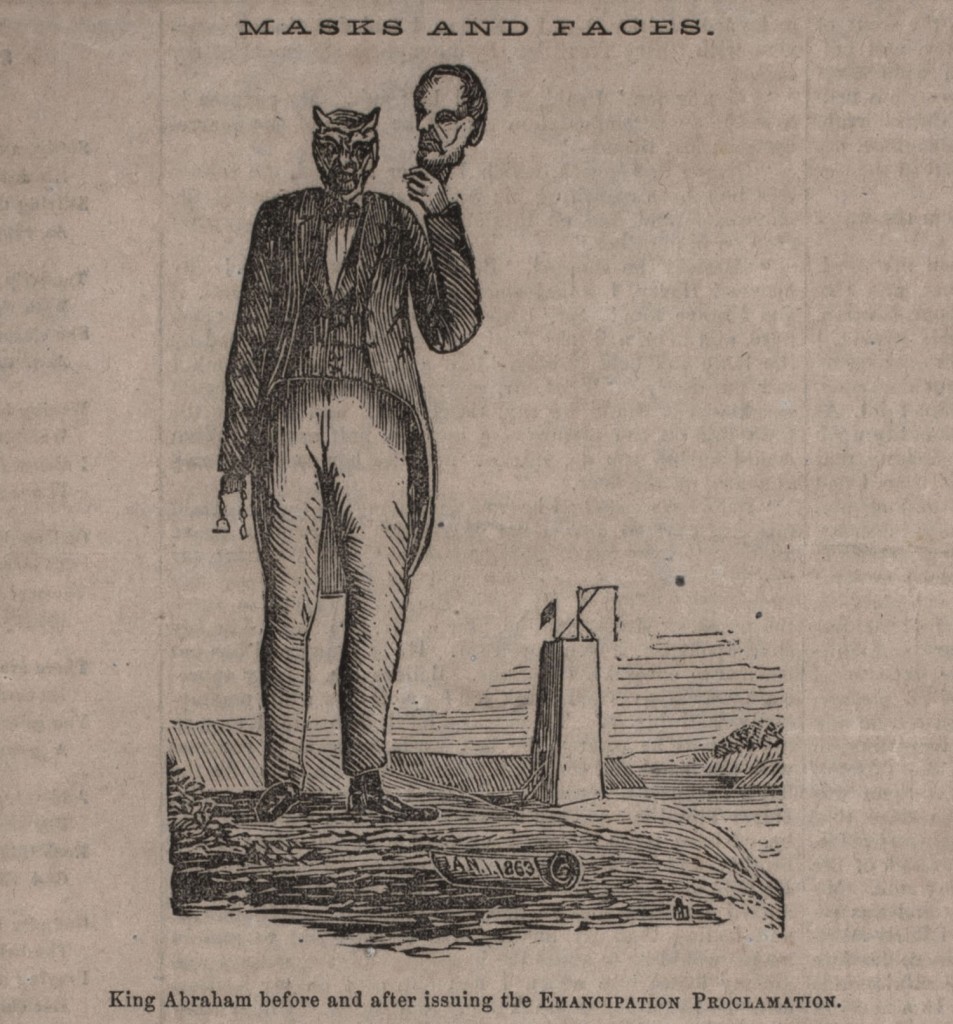Disclaimers always add something titillating to a post, so here goes our very own…  This post focuses on reporting in the South, but the war of words worked both ways during the Civil War. The northern press could be inaccurate, hypocritical, and disingenuous. We would love to read examples you have found in your own research of strongly sectional reporting, or perhaps someone would be willing to write a follow up post highlighting the slanted reporting of northern presses? In the meantime, here are some examples our volunteer found in one southern newspaper (including a cartoon of Lincoln as the devil!).
This post focuses on reporting in the South, but the war of words worked both ways during the Civil War. The northern press could be inaccurate, hypocritical, and disingenuous. We would love to read examples you have found in your own research of strongly sectional reporting, or perhaps someone would be willing to write a follow up post highlighting the slanted reporting of northern presses? In the meantime, here are some examples our volunteer found in one southern newspaper (including a cartoon of Lincoln as the devil!).
While the armies of the United States and the Confederacy fought on the battlefield, newspapers North and South waged a war of words. With skills honed during the contentious decades before the war, writers launched salvos back and forth from their well-stocked arsenals of rhetoric. In this post, I have chosen some of the most sharply pointed attacks penned by southern newspapermen in The Southern Illustrated News [AAS online catalog record] against the perceived “inborn malignity” of their Yankee foe.
Unsurprisingly, the Southern writers were eager to demonstrate the inferior qualities they perceived in northern culture, people, and government compared with the Confederacy. Culturally, the “Yankee” was lambasted as “an imitative animal,” and “utterly devoid of original genius.” The writers even find fault with the way northerners speak and write. They accuse Yankees of torturing the English language “in a most inhuman fashion,” distorting it into “an unknown tongue, leaving scarcely any trace of its parentage.” Furthermore, the Union government is viewed with utter contempt. In the past, they allege, “great Southern Presidents” had made for the United States “all of its history which is not absolutely contemptible. Now, they claim, “The government there is a military despotism, as absolute as that of Russia.”
Although the whole north was vilified and derided, New England was singled out for the strongest venom in the southern press, because it had been the center of abolitionism before the war and because many southerners resented its cultural preeminence in mid 19th century America. One angry writer labeled it “that benighted corner of the globe.” Clearly, in this heated climate, facts were less important than rallying support for the cause and opposition to the enemy.

Additionally, in many articles writers strove to create a distinct identity that stood on its own and was not based solely on opposition to the North. A common complaint is that southern creativity had been stifled before the war because the North had “supplied us with every article of daily use,” from farm implements to books, placing the south in “a state of colonial vassalage.” Continuing along these lines, the burning of the College of William and Mary by United States troops gave The Southern Illustrated News an opportunity to allege that the reason for the destruction was the Yankee determination to make themselves “the exclusive patron of learning and science on this American continent.” To make the hoped-for independence of the Confederacy complete, cultural as well as political independence must be achieved through the development of, among other things, “a vigorous, healthful literature” which will “speak for us and our society in the intellectual forum of the world.” The anger and resentment at so-called Yankee domination is clear in these statements, but there is also an undercurrent of uncertainty since, having rejected one culture, the South had not yet built another.
Despite the ferocity of these statements, the writers reserved their most bellicose condemnation for what they viewed as the dishonorable tactics used by the “murdering rascals in Washington.” After both Antietam and Gettysburg, they accuse the Federal armies of leaving the field of battle in the face of Lee’s army, only to return after the Confederates had retreated on their own accord in order to claim victory for the North. Though historically inaccurate, it did allow The Southern Illustrated News to declare that Union generals, although they cannot outfight their rebel counterparts, can out-lie them. Furthermore, the newspaper laments that the south is “beset on all sides by a rapacious, vindictive and powerful foe which respects neither age nor sex in the execution of its fiendish purposes.” Descriptions of the allegedly heinous acts committed by Union troops became so commonplace that, in November 1862, it was necessary only to say that during an invasion of the North Carolina coast the Yankees had perpetrated their “usual atrocities.” Readers could use their imagination to fill in the details.
In this way, The Southern Illustrated News presented a dual narrative of the war in which Southerners were brave and honorable soldiers defeating the Yankees through great feats of arms, while at the same time were the oppressed victims of a ferocious, marauding enemy. Confederate supporters could feel pride in Southern martial prowess and self-righteous indignation as victims all at the same time.

The civil war is part of our heritage, the South was and is America. Look at the facts- how many confederate soldiers actually owned slaves. The fight I imagine took place is much the same as the struggle we are going through now, a government gone mad with power, with no possible way of stopping it other than an armed revolt.
History repeats itself.